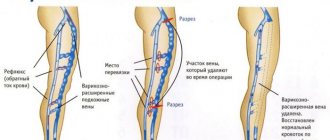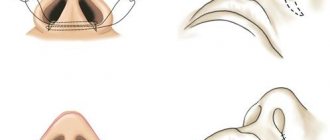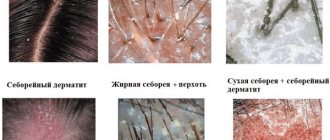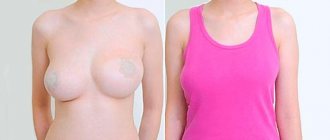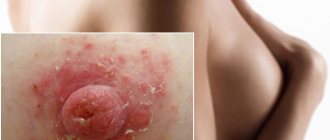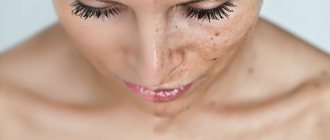Excessive sweating of the hands and feet (extremity hyperhidrosis) is not only a hygiene problem, but also a painful condition. Some clinical cases are caused by various pathologies of the endocrine system, infectious infections and neurological disorders. Elimination of hyperhidrosis is carried out using external means (baths, creams) and hardware procedures.
Causes of sweating, hyperhidrosis of the palms and feet
- First, it’s worth understanding the reasons for the appearance of excessive sweating in order to understand how it can be worked with and prevented in the future.
- There are actually many reasons, but the most common reason (in 90% of cases) is a high concentration of sweat glands in the body. Note that this is congenital, and is most often passed on from generation to generation.
- From which we can draw a certain conclusion - you were born this way, and it is impossible to completely cut it off from yourself. But you can solve the problem, and also help your children solve the problem, because most likely, either they or their children will have it
Causes of sweating, hyperhidrosis of the palms and feet
Sweating also depends on the psychological reaction to stress and other external stimuli, adolescence, as well as hormonal imbalance.
And one more thing: if you have never experienced sweating and are now taking medication, hyperhidrosis may be a reaction to the concentration of the drug in the body.
Video: Excessive sweating - hyperhidrosis
There are two types of hyperhidrosis:
- General. The cause may be high temperature, active physical activity, or an unusual emotional situation that causes fear, panic, and even euphoria. The reason may also be the dryness of the room, and the body is trying to “moisturize” itself.
- Localized. These are most often the palms, feet and large folds. The reason here is most often emotional, as well as congenital (the concentration of sweat glands in this part of the body)
Stress
Even sweating during stress is also a normal and natural function of the body. This has nothing to do with our problem. If the stress goes away, then the sweating goes away too.
Another thing is that whoever has hyperhidrosis experiences stress throughout their life. And the only period when people do not sweat is at night. During sleep, the body is most relaxed. As a result, the person is calm and sweats less.
But as soon as he wakes up and starts having breakfast, his armpits and palms immediately become wet. Plus, sweating increases during periods of excitement.
Stress, oddly enough, is indirectly related to hyperhidrosis. This causes increased sweating. And if a person starts to sweat a lot, then he becomes even more stressed.
The result is such a vicious circle. A person begins to think that he is about to sweat, after which this excitement overtakes him.
Sweating during pregnancy
Sweating during pregnancy is a normal and natural physiological condition due to a certain imbalance of extragens and progesterones. In this case, there is no need to worry, since upon normalization, profuse sweating will disappear.
But another thing is that pregnancy can sometimes act as a trigger for local hyperhidrosis
.
Many patients may say that if sweating did not bother them before pregnancy, then after childbirth it began to manifest itself very actively.
Thyroid
In some cases, when the thyroid gland is active, increased sweating may occur. Especially the torso.
However, it is worth adding that such an ailment, as a rule, does not appear as the first symptom of a thyroid problem. Therefore, here you need to think about other diseases.
Heavy sweating at night
General hyperhidrosis
- this is the situation when you need to think about any diseases. But the difference here is that with local hyperhidrosis there is never heavy sweating at night.
Whereas general hyperhidrosis occurs very often and even at night. Therefore, night sweats are a sign of some kind of disease.
If you have excessive sweating at night and during the cold season, I recommend that you first pay attention to the room temperature. There are many people who are used to sleeping in a warm room. As a result, they unknowingly provoke their sweating.
If you have night sweats and an unpleasant odor, then this is a very bad signal! You definitely need to undergo a general medical examination
.
First of all, you need to go to a therapist and do the usual screening tests. This is a general blood test, biochemistry, chest x-ray.
Microbes
Very often a person is bothered by the smell of sweat. This is a problem of local microbial background in the armpit areas. The skin of any person carries saprophytic microbes. They do not cause serious problems.
However, in certain situations, these microbes, combined with the sweat produced by the apocrine sweat glands, create a problematic odor.
It is very difficult to get rid of sweat here. It is necessary to suppress sweating and at the same time fight the functioning of these microbes. I will say that this is a certain characteristic of a person. After all, our ancestors used to recognize themselves by smell.
How to deal with hyperhidrosis of the palms and feet?
How to deal with hyperhidrosis of the palms
We live in a society, and as soon as a child begins to attend a child care facility, until his very last breath in old age, he must say hello by shaking hands, hug when meeting, and also take off his shoes when visiting, etc.
Sweating of the feet and hands causes a lot of difficulties and even complexes. But we live in the age of nanotechnology, and we can certainly cope with such a difficulty!
When is hyperhidrosis treatment effective?
We currently have several treatment methods:
- Folk remedies
- Tablets and ointments
- Botox injections
- Surgical intervention
First of all, we would not recommend self-medication, especially if sweating began in adulthood.
- The doctor, unlike you, will analyze the situation in detail, take all the necessary tests and tell you how serious the situation is and what measures should be taken
- Many people perceive traditional methods as a panacea, and doctors as a species trying to prescribe chemistry. Don’t worry, if there are no significant reasons, the doctor himself will advise you on a folk remedy that has been proven over the years
- But if you look at a hormonal imbalance or other disorder of the body, despite the fact that it so actively “signaled” with the help of sweat, time may be irretrievably lost
Features of treatment in children, women and men
- Treatment of hyperhidrosis in children requires more gentle methods than in adults. Therefore, for young patients:
- physical therapy is prescribed, for example, electrophoresis (exposure to problem areas with a weak current in combination with medications);
They use various powders (based on alum, boric acid, etc.) and special cosmetics - La Cree products (creams, cleansing gels, balms, etc.).
- As for the treatment of excessive sweating in women, in most cases, patients are recommended hormonal therapy (since the cause of severe sweating is most often caused by hormonal disorders in the body), iontophoresis, injection injections and treatment with laser radiation, since these methods are less painful and do not leave scars on the skin.
- To relieve symptoms, men are advised to use medicated deodorants and antiperspirants, as well as pharmaceuticals. As therapy, representatives of the stronger sex are prescribed:
- physiotherapy;
- iontophoresis;
- in especially severe cases - surgical intervention.
The course of treatment is prescribed by the doctor.
Folk remedies for sweating and hyperhidrosis
This disease can be treated both by taking the medicine internally and externally. But the best way is to combine.
Traditional methods of hyperhidrosis
For indoor use:
- Tea with lemon balm (not to be confused with mint) reduces sweating, especially in the palms of the hands.
- Another recipe: pour 2 tablespoons of sage into a glass (200 g) of boiling water in a thermos and let it brew for half an hour. Drink 60-70 grams of infusion 2-4 times a day. It is best to brew daily, but can be stored in the refrigerator for up to 3 days. Take no more than 2-3 weeks, as sage contains a substance - thujone, which, when accumulated, causes cancer
Video: Excessive Sweating of Hands, Feet and Armpits. How to fight hyperhidrosis? EXPERT Speaks
For external use:
- It is advisable to supplement the internal use of lemon balm with medicinal mint baths. Can also be combined with walnut, chamomile, sage, and beech leaves
- If you want to strengthen blood vessels, reduce sweating and improve skin health, take baths with oak bark. Pour a liter of boiling water over a pack (100 g) and cook over low heat for half an hour, then pour into the bath and take immediately. You can have a general bath, or you can have a local one
- Crushed oak bark is poured with boiling water until it just covers the bark and infused for 15 minutes. Pour into gloves and socks and wear throughout the night. In the morning, wash off with cool water. Please note that oak can stain clothing and bedding. Therefore, these days, do not make new bedding and do not wear clothes that you would be sorry to throw away.
- Potato starch can also be poured into gloves and socks at night. The advantage of this method is that it leaves no traces
- Baths with ammonia at the rate of 1 teaspoon per liter of water. Keep your hands in warm water for 10 minutes, then rinse everything off with cool water, blot dry with a paper towel and powder with talcum powder.
- Squeeze lemon juice into a spray bottle, twist tightly and spray your hands several times a day and whenever they start to sweat. Antiseptic bottles, which can be purchased in every supermarket, are well suited for this role.
- Lemon juice is an excellent substitute for wine or apple cider vinegar. But here you should be careful and dilute with water 1/1 or even 1/3 where 3 parts are water
- Another method: infusion of birch buds with vodka. Press the buds tightly into a glass bottle, fill to the top with vodka, and leave in a dark place. Wipe your palms and soles 1-2 times a day
- In summer, beer baths help with excessive sweating, but the beer must be live and not powder
Tablets and remedies for sweating, hyperhidrosis of the palms and feet
This chapter will focus on over-the-counter medications, but this does not mean that they can be purchased without consulting a doctor. Remember, in treatment it is important not only to get results, but also not to cause harm.
Foot wipes for hyperhidrosis
Formidron . The active ingredient is formaldehyde; in addition to it, the preparation contains alcohol and cologne. Our parents fell in love with this medicine in Soviet times; pharmaceuticals never offered a worthy alternative for price/quality. Using a tampon, it is necessary to apply to problem areas for 2-3 weeks at night, but you can extend the course if necessary.
Formidron
Formagel . Currently, doctors recommend this drug as the most highly effective and containing the maximum amount of formaldehyde. This is a colorless gel that can be used for a long time. According to clinical studies, it is worth using the drug for one day and sweating will decrease for 1-3 weeks. It is recommended for use on the palms, armpits and feet.
Formagel
Teymur's paste . The proven remedy, however, is very inconvenient. You need to use it 2 times a day, it stains clothes and bedding. As soon as other medications and ointments appeared, the paste immediately became less and less attractive.
Teymurova paste
Sedatives . If the cause of hyperhidrosis lies in the psychological state of a person, then first of all it is necessary to eliminate the cause, and in parallel with this, other medications can be prescribed. Tranquilizers are most often prescribed, but it is worth remembering that they are persistently addictive.
Sedatives in the treatment of hyperhidrosis
Herbal preparations . Preparations based on belladonna alkaloids are also very common in the treatment of excessive sweating. The most common of them are Belloid, Bellaspon and Bellataminal. Please note that herbal tablets are not addictive.
Herbal preparations for the treatment of hyperhidrosis
Treatment of hyperhidrosis of the palms and feet with Botox
In the event that doctors have tried all medicinal and traditional methods of treatment with the patient and have not achieved the desired result, the doctor may offer another treatment option - Botox or Dysport.
The mechanism of action is intradermal administration of a drug that blocks the transmission of impulses from nerve endings to the sweat glands, thus fundamentally combating the problem of sweating.
Treatment of hyperhidrosis of the palms and feet with Botox
The method is truly effective, and 100% effective, but the method has a lot of contraindications and complications. Therefore, it is necessary to agree to it only in extreme cases. Also, the method is not permanent and will have to be repeated every 6 months.
Video: Botox for sweaty hands
Characteristics of hyperhidrosis
Excessive sweating is a normal condition for humans or a variant of pathology. The first option manifests discomfort, which reduces the quality of life. Hygiene procedures and relieving psycho-emotional stress will cope with the problem. It is necessary to use antiperspirants; they prevent sweat from forming and have an antibacterial effect.
If the problem is caused by illness, you should consult a therapist or endocrinologist. The diseases can be quite serious.
Hyperhidrosis of the palms and feet in a child
Local hyperhidrosis of the palms and feet in children does not appear often and has not been fully studied by medicine. Until now, no doctor can say for sure the reasons for the appearance.
But this does not mean at all that you should not treat this with the utmost care and expect that it will go away on its own. As soon as you notice regularly wet palms or wet socks on your child, while the child is dressed for the weather and the temperature outside is comfortable for the body (not hot summer), you can immediately consult a doctor.
Hyperhidrosis of the palms and feet in a child
A doctor, usually a dermatologist, must order a series of tests to rule out disorders in the body, and then prescribe appropriate treatment.
If the problem appeared in childhood and was not resolved, there is no point in relying on successful treatment in adulthood. Love your children and treat them as soon as you notice the disease.
Video: Hyperhidrosis in a child
Classification
- By age: primary (in adolescence under the influence of hormones), secondary (in mature people under the influence of the disease).
- By localization.
- General. Occurs on the entire surface of the body. It is accompanied by endocrine disorders or diseases of various origins. Divided into gustatory and idiopathic.
- Local. Located on a certain area of the body (axillary area, sole of the feet). Caused by nervous disorders. Without an etiology, the problem is considered by a doctor, it is a symptom of a disease of the endocrine system.
Hyperhidrosis of the palms and feet: View reviews
Kirill: For as long as I can remember, I hated the “man’s handshake” because my hands were wet and sticky. My parents complained, but my grandmothers convinced them that it was temporary and would go away as soon as I grew up. It’s gone because I inject Botox every six months. Other methods are not effective, because the disease is advanced. My advice is if your body is sweaty for more than a week, see a doctor. It is better to hear that you are an abnormal parent than to start the disease.
Natalya: after giving birth I started sweating a lot, nothing helped. I went to the hospital and was diagnosed with a hormonal imbalance with hyperhidrosis. They prescribed pills and baths with oak bark decoctions, tea with lemon balm, and so on. It all happened in 2 months. Here, the sooner you apply, the more gentle the treatment will be.
Types and reasons for the development of this condition
Hyperhidrosis of the extremities is divided into primary and secondary. The latter is said if increased sweating is caused by a disease or pathological condition of the patient. The reasons for the appearance of secondary are as follows:
- infectious diseases (tuberculosis, malaria);
- taking certain medications;
- pregnancy;
- genetic disorders (cystic fibrosis, etc.);
- menopause;
- hormonal imbalances;
- Hodgkin's disease;
- diseases associated with metabolic disorders (thyrotoxicosis, diabetes mellitus, hypoglycemia, pheochromocytoma);
- neurological disorders (Parkinson's disease, neurosyphilis), etc.
Excessive sweating is often associated with a psycho-emotional state, nervous tension, and constant stress.
As for primary hyperhidrosis, its appearance is caused by high activity of the sympathetic nervous system. There are other classifications of this disease. The disease is divided into:
- diffuse (or generalized), in which increased sweating is a symptom of another disease;
- limited (or local), in which certain areas of the body suffer (hyperhidrosis of the face, feet, palms, armpits, etc.).
Fact! It has been proven that about 2% of people worldwide suffer from excessive sweating.
Excessive hand sweating may be associated with certain diseases
reading information
Hyperhidrosis - what is this disease?
Hyperhidrosis is excessive sweating of a specific area of the body or the torso as a whole. Hyperhidrosis can be a congenital feature of the body, or it can develop as a result of another disease, for example, against the background of obesity, tuberculosis or thyroiditis. The word hyperhidrosis comes from two Greek derivatives: “hyper” and “hidros,” meaning “excessive” and “sweat.”
If a person is absolutely healthy, then his sweating will increase, provided that the ambient temperature rises above +20 °C Celsius. Psycho-emotional stress (stress, excitement, fear), physical work, and consumption of significant amounts of water also become triggers for increased sweat production.
Hyperhidrosis of the armpits is a local increase in sweating. Similar pathological manifestations include increased sweating of the palms, forehead or feet. The second name for armpit hyperhidrosis is axillary hyperhidrosis. In addition to the fact that the process of sweat separation itself intensifies, its smell also changes, which becomes foul.
According to available statistics, about 2% of the world's population suffers from hyperhidrosis. Although doctors say that this indicator can be much higher, since not every person with a similar feature of the body turns to specialists for help. Hyperhidrosis is more often observed in women, which is explained by their increased emotionality and hormonal instability during certain periods of life. A considerable part of people with hyperhidrosis are teenagers, since it is during the transition period that the maximum activity of the sweat and sebaceous glands is observed. After the age of 50, this problem becomes less and less relevant, as the sweat glands begin to work worse.
Despite the apparent frivolity of the problem, it can cause a person significant discomfort. Knowing about this feature of the body, a woman or man will constantly be in anticipation that sweating will intensify at the most inopportune moment, for example, in a crowded place. Constantly being in nervous tension leads to the problem getting worse. As a result, a vicious circle is created, from which it is almost impossible to find a way out on your own. If a person develops local hyperhidrosis, and he does not find any objective reasons for this, then he should not delay contacting a doctor. The fact is that this pathology may indicate the development of serious diseases.
Treatment
If you experience excessive sweating of your feet and hands, you should consult a doctor.
Remember. Today there are many ways to combat this condition. The doctor will help identify the root cause of the pathological process and prescribe an appropriate course of treatment.
Different doctors treat foot hyperhidrosis. To exclude fungal diseases and anatomical defects of the legs, consultation with a dermatologist is necessary. If excessive sweating of the feet is associated with a psycho-emotional state, you should contact a neurologist. To exclude pathological disorders of the endocrine glands, you will need the help of an endocrinologist. Each case is individual.
Often, increased sweating of the feet occurs in men and women due to wearing tight or poor-quality shoes
To treat hyperhidrosis of the legs and arms, the following means and methods are used:
- Iontophoresis. This physiotherapeutic procedure is performed by exposing the limbs to an electric current with an ionizing substance. The patient places his feet or palms in special containers of water, and the device generates a weak electric current. The procedure lasts no more than 40 minutes. The course of treatment is 7-10 days. The duration of the effect can be up to six months.
Fact! Iontophoresis is the most effective treatment for hyperhidrosis of the feet and palms. According to medical statistics, physiotherapy helps in 80% of cases.
- Ointments, antiperspirants. These drugs reduce sweating and eliminate unpleasant odor by blocking the excretory ducts of the sweat glands. The most effective are those that contain aluminum chloride.
- Botulinum toxin, or botulinum toxin type A (Botox). Botox subcutaneous injections are used to treat hyperhidrosis of the legs and armpits. The drug disrupts the functioning of the glands responsible for sweating by blocking their nerve endings. The patient's sweating decreases after a few weeks. The blocking effect can last up to a year.
If none of the listed methods for treating limb hyperhidrosis help, patients may be prescribed surgery to block nerve pathways or remove sweat glands (endoscopic sympathectomy, curettage, etc.).
On pharmacy shelves you can find many products to reduce sweating and eliminate odor. However, the effectiveness of such drugs is very low.
Diagnostics
To diagnose hyperhidrosis, you must consult a therapist or dermatologist. The doctor will interview the patient and examine him. This will allow him to suggest one or another cause of the pathological condition and prescribe treatment. In some cases, consultation with other specialized specialists (neurologist, endocrinologist, oncologist) is required.
If hyperhidrosis has a psychogenic basis, then it will be possible to trace its beginning, which is often closely related to psychological trauma. Sweating in such patients increases during moments of nervous overstrain or at night. Periods of remission are observed against a background of emotional calm. In addition to the armpits, the face, feet and palms sweat intensely.
If a person has primary hyperhidrosis, that is, one that develops against the background of congenital disorders of the sympathetic nervous system, then a number of signs will indicate this. Hyperhidrosis in this case manifests itself in childhood or adolescence, a similar situation can be observed in other family members. There is no connection with emotional overexcitation and increased sweating. In addition to the armpits, primary hyperhidrosis can be observed on the feet and palms.
If hyperhidrosis occurs not only in the armpits, but throughout the body, then the endocrine nature of the pathology can be suspected. At night and in the evening, sweating increases, so much so that a person is forced to constantly change clothes. Possible redness of the skin of the body and face.
Laboratory tests that are prescribed for a patient with hyperhidrosis:
- General and biochemical blood test.
- Fluorography.
- Blood test for thyroid hormones, glucose levels, syphilis, HIV, hepatitis.
- General urine analysis.
The following studies help to carry out a qualitative and quantitative assessment of sweat:
- Minor's test makes it possible to determine the boundaries of the area that is characterized by increased sweating. The skin is thoroughly dried, and then a solution of iodine and starch is applied to it. Those places where areas with overactive glands are located will be colored black and blue. This procedure is performed when surgery is planned.
- To be able to choose the optimal treatment and diet, it is necessary to study the chemical composition of sweat. This procedure is called chromatographic analysis.
- A sheet of filter paper is applied to the armpits to determine the amount of sweat produced per minute. This method is called gravimetric. It allows you to assess the severity of hyperhidrosis.
By paying enough attention to interviewing the patient and methods for diagnosing hyperhidrosis, the doctor will be able to accurately determine the cause of the pathology and prescribe the appropriate treatment.
Folk recipes
Excessive sweating of the feet and palms in men and women can be combated at home. Traditional healers recommend:
- make medicinal baths for limbs based on lemon juice, oak bark or apple cider vinegar;
- for general hyperhidrosis, take warm baths with mint, chamomile infusion and sage;
- for foot hyperhidrosis, wear socks filled with crushed oak bark at night;
- wipe your palms and feet with lemon juice several times a day, etc.
Hyperhidrosis of the extremities cannot be cured using folk methods alone. Baths, herbal applications, decoctions and compresses are effective only in combination with traditional treatment.
reading information
Which doctor should I contact for treatment?
If, after reading the article, you assume that you have symptoms characteristic of this disease, then you should:
With hyperhidrosis, sweat, as they say, flows like a stream
The course of hyperhidrosis causes concern in the social sphere. Many patients tend to withdraw from other people. They suffer from hyperhidrosis and become depressed. Physical limitations arise in mechanical activities. Sweaty hands due to hyperhidrosis can affect the performance of instruments or keyboards.
Relative frequency per 000 inhabitants per federal state. There are sweaty spots or very unpleasant odors that can pollute the environment. Often the disease leads to social isolation. An interested person often avoids events and events. Especially on hot summer days, hyperhidrosis can lead to serious mental health problems and even depression. Pathological sweating can negatively affect relationships.
What is local hyperhidrosis? Translated from medical language, this is increased sweating. But not the kind that appears to almost everyone in a bathhouse or in the heat. With hyperhidrosis, sweat, as they say, flows like a stream.
The word “local” means “local”, that is, specific places on our body sweat (as opposed to general, when sweat abundantly covers the entire person).
Children also suffer from bullying and teasing as symptoms of childhood hyperhidrosis. If dehydration occurs, it has a very negative impact on the patient's general condition and may continue to lead to unconsciousness. Treatment for hyperhidrosis can be done by removing the sweat glands. This usually gets complicated. Additionally, medications may also be used to prevent abnormal sweating.
Treating hyperhidrosis as a secondary condition treats and cures the underlying condition. For primary disease, mild sweat inhibitors are first used in mild cases. The sweat inhibitor aluminum chloride, which exists in industrial deodorants, is especially concentrated in the medical version. The active ingredient tightens the pores and in some cases reduces sweat production. Also used for hyperhidrosis is botulinum toxin therapy. It is an effective nerve agent. The nerve triggers are stopped and the sweat production of hyperhidrosis is reduced to an acceptable level.
To put it simply, local hyperhidrosis is always wet armpits or palms, feet, or face. Wherever there are areas of excessive sweating, this disease traumatizes the human psyche and causes fear of communicating with other people. It would seem - what's special here? Well, your armpits are sweating - you need to wash and spray with antiperspirant, fortunately there are plenty of them in pharmacies and stores today...
Which doctors treat local hyperhidrosis?
But it's not that simple. You wash yourself several times a day, wipe yourself dry, spray deodorants on yourself or sprinkle talc on your palms... And everything is useless. Sweating continues to plague you. In this case, you should definitely consult a doctor.
Since the sweat glands are located in close proximity to the skin, hyperhidrosis is treated mainly by dermatologists. But if hyperhidrosis is caused by another serious illness - tuberculosis or diabetes mellitus, then the treatment is carried out by a specialized doctor - a phthisiatrician (in the case of tuberculosis), an endocrinologist (treats hyperthyroidism and diabetes mellitus), a neurologist or a psychotherapist (if nervousness has reached its limit and you are afraid to communicate with people).
In addition, hyperhidrosis is treated by oncologists, if the patient is diagnosed with a tumor disease, and by cardiologists (some diseases of the cardiovascular system are accompanied by local hyperhidrosis). Toxicologists treat poisonings, which also cause local hyperhidrosis.
Of course, the main disease is given the most time, but specialists try to alleviate the symptoms of local hyperhidrosis for patients. Moreover, if the treatment of the underlying disease is successful, then the hyperhidrosis caused by it gradually goes away.
Narcologists get involved in cases where the patient exhibits withdrawal symptoms - after stopping the use of alcohol or drugs. But in the latter case, general hyperhidrosis often appears, although local hyperhidrosis also sometimes occurs.
Vegetative-vascular dystonia (VSD) is also one of the causes of local hyperhidrosis. The diagnosis is made by a general practitioner or neurologist after a thorough examination.
Preventive measures to reduce excessive sweating
To reduce the manifestation of hyperhidrosis, doctors recommend following simple rules:
- observe the rules of personal hygiene;
- eat right, exclude coffee, alcohol, fast food, etc. from your daily diet;
- wear comfortable clothes and shoes made of natural fabrics and materials (linen, cotton, silk, etc.).
There are many ways to treat hyperhidrosis of the extremities, the main thing is to identify the root cause of the pathology, and then deal with unpleasant symptoms.
Source
Is hyperhidrosis dangerous, how to treat it with medications, ointments and traditional medicine.
Preventive actions
To prevent attacks of hand hyperhidrosis, you need to change your lifestyle. Prevention of exacerbations of the disease includes compliance with the following recommendations:
- wear clothes made from natural materials;
- reduce body weight, since excess weight leads to excessive sweating;
- Avoid excessive alcohol consumption – such drinks activate blood circulation, which can stimulate sweat production;
- eliminate stressful situations.
How does it arise
Hyperhidrosis can be idiopathic or secondary. In the first case, sweating occurs for no specific reason. In this case, your armpits, palms and feet sweat a lot. In the second case, the pathology is associated with diseases of the internal organs, when sweat is secreted over the entire surface of the skin in large quantities.
Basically, hyperhidrosis occurs when there is a disruption in the functioning of the autonomic nervous system. This can be frequent stress, tension, various diseases, changes in hormonal levels, etc.
In addition to stress, hyperhidrosis occurs against the background of poor nutrition, environmental conditions, and bad habits. Sweaty palms may occur when taking certain types of medications.
Causes
It is quite difficult to establish the exact causes of hand hyperhidrosis. Many factors lead to the problem.
The most likely ones include the following:
- A large number of sweat glands. Some people, due to hereditary predisposition or other factors, have too many sweat glands on the surface of their palms. This causes an increase in sweat production and can cause other symptoms of hyperhidrosis.
- Nervous system lesions. The functioning of the sweat glands depends on the functions of the autonomic nervous system. Disruption of its functioning can lead to an increase in the amount of sweat, which is produced when body temperature increases due to physical activity or stressful situations. If there are problems in the functioning of the nervous system, there is a risk of hyperhidrosis developing for no apparent reason.
- Problems in the functioning of the endocrine system . The functioning of the thermoregulation system is seriously influenced by the endocrine glands, including the thyroid gland. Hormonal imbalance, which occurs with various abnormalities, including diabetes, provokes a change in the amount of sweat produced.
- The cause of hand hyperhidrosis can be pregnancy, puberty, menopause and other conditions that are characterized by changes in the balance of hormones.
- Nervous and mental disorders . The work of the sweat glands directly depends on the mental and emotional state of a person. People who are highly emotional are much more likely to suffer from hyperhidrosis. Similar problems are typical for patients with mental disorders. Violations of a hysteroid nature are especially dangerous.
- Infectious pathologies . Many diseases of this type, such as tuberculosis, are accompanied by a significant increase in temperature and severe sweating. Addressing the underlying cause helps to completely relieve the symptoms of hyperhidrosis.
How can you treat hyperhidrosis of the palms, feet or hands?
To get rid of severe sweating, it is necessary to maintain personal hygiene, as well as strengthen the nervous system. The easiest way to get rid of the disease is to use antiperspirant deodorants. They block the sweat glands, which reduces the amount of sweat produced.
If the patient has secondary hyperhidrosis, the underlying disease is first cured. To do this, you will need to undergo an examination and obtain a doctor's prescription.
Ultraviolet light has a good effect, which helps to overcome severe sweating of the hands. You can try an ionization session, which is performed by a dermatologist.
It is better to use special powders for the palms and feet
Medicines
To reduce sweating, sedatives are prescribed to help reduce stress and tension. If this does not produce results, drugs with belladonna and belladonna, which are not addictive, are prescribed:
- Bellaspon - the drug helps reduce sweating and also has a calming and sedative effect.
- Belloid – helps overcome irritability and nervousness.
To reduce nervous excitability, drugs with bromine (Propintheline) are prescribed. It reduces the amount of sweat produced.
In advanced forms of hyperhidrosis, tranquilizers can be prescribed to improve a person’s mental state. For excessive sweating, Diazepam, Oxazepam, etc. can be prescribed.
Tranquilizers are prohibited for use by pregnant women and those with severe depression.
Ointments and creams
To combat severe sweating, ointments and creams can be prescribed:
- Cream “5 days” - this drug has an antiseptic, drying, deodorizing effect, and also relieves inflammation on the skin.
- Cream "Nepotoff" - helps to overcome the unpleasant odor of sweat.
- Formagel - the drug helps relieve the unpleasant symptoms of severe sweating, as well as reduce sweating.
- Teymurov's paste - has an antiseptic, antimicrobial effect. Dries the skin and fights the unpleasant odor of sweat.
- Lassara paste - helps eliminate heavy sweating, fights its symptoms and helps to quickly get rid of the disease.
Folk recipes: list
To quickly get rid of unpleasant sweating on the palms, folk remedies are used:
- Baths with potassium permanganate - for this you will need to prepare warm water, to which you add a couple of grams of potassium permanganate so that the water turns pink. After this, hold your hands in it until the condition eases, dry and lubricate with powder or deodorant.
- Vinegar baths - for this you need to take 3 tsp. vinegar and a liter of warm water. Such baths should be done for 2 weeks three times a day.
- A mixture of vinegar, soda and borax - this will require 100 grams of vinegar, 1 tsp. soda, mix everything thoroughly. After the mixture has stopped fizzing, 4 grams of borax and 300 grams are added to it. glycerin. Pre-dissolve borax in half a glass of warm water. Wipe your hands with the resulting mixture every 2 hours.
- Herbal baths - you will need half a liter of hot water and 1 tbsp. horsetail and calendula. All ingredients are mixed and infused for half an hour. After this, strain the broth and dip your fingers in it for 15 minutes. This procedure should be done every day until sweating decreases.
- Baths with salt – 1 tsp. salt 1 liter of warm water. You should immerse your hands in the resulting liquid for half an hour. You need to do this procedure 3 times a day.
Pharmacy products
This category will most effectively be determined by a therapist or endocrinologist:
- Medicinal antiperspirants. Dangerous due to blockage of pores. The infection accumulates. There is a possibility of developing an infection.
- Medicines to help cope with nervous disorders. Belladonna extract preparations have a sedative effect. An additional effect is a decrease in the secretion of sweat glands.
- Tranquilizers. They are used for mental disorders and have an antihydration effect (Diazipam).
- Bromine preparations. Indications for use: increased sweating (hyperlactation, hyperhydration).
How long does it take to treat hand hyperhidrosis?
The duration of treatment depends on the duration of the disease, as well as its stage. On average, it takes 2-3 weeks to treat hyperhidrosis. But already from the first days of treatment, the patient observes relief and less sweat.
With hyperhidrosis, the most important thing is to follow the rules of hygiene. It is necessary to treat the skin of your palms daily with antiseptics and deodorants, make herbal baths, etc. If there is a smell of sweat, then cosmetic deodorants are suitable.

